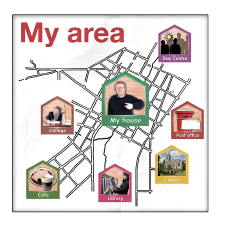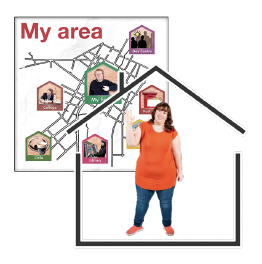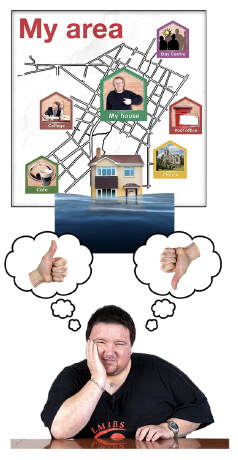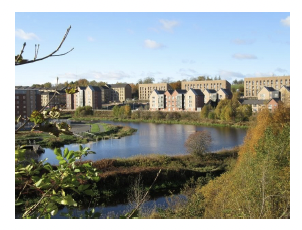Flood resilience strategy consultation: easy read
This consultation seeks your views on Scotland's first Flood Resilience Strategy, which will lay out what we need to do in the long term to make our places more flood resilient. The consultation asks questions about our proposed principles and the three key themes of people, places and processes.
What is in the flood resilience strategy?
The flood resilience strategy has 3 parts.

- People - Involving people in decisions about flood resilience in their places and showing what they can do.

- Places - Making changes to our places to improve our flood resilience.

- Processes - Making changes to the way we do things and the way we work together.

People
Flooding can affect our lives and our physical and mental health for long after the flood event itself.

People and communities are at the centre of the flood resilience strategy.
We want to make sure that people are included when decisions are made about their places.

People must have the right information and evidence to help them take part.
Evidence is information that tells us if something is true.

It helps us to make decisions about what to do.

We must help people to understand how flooding might affect them and their place.
People must be able to get good, up-to-date information about the chances of flooding in their area, now and in the future.

We need to:

- have better ways to work with communities and support people to be able to take part in making decisions

- develop ways to support communities to improve their own flood resilience including through:
- changes they can make in their property
- access to local groups that can help them become more flood resilient

Questions
4. What support do communities need to take part in flood resilience planning?

Write or type your answer here:
5. What should local councils do to help communities become more involved in making decisions about improving flood resilience?

Write or type your answer here:
6. What would help communities understand:
- how likely their area is to flood, now and in the future?
- what can help them become more flood resilient?

Rank from the most to the least important.
1 is the most important
5 is the least important

- Flood maps that show where flooding is likely to happen
- Local flood history
- Information on how a community can work on flood resilience
- Flood resilience advice and support
- Information about what flood resilience work could be done in their community
Other – please tell us what.
Write or type it here:
7. What could communities do to make their flood resilience better?

Rank from the most to the least important.
1 is the most important
4 is the least important

- Set up a local community flood resilience group
- Make a local plan about how to cope with flooding
- Share local knowledge of what happens during floods, with organisations like SEPA and local councils
- Link with a local climate action group
Other – please tell us what.
Write or type it here:
8. What could householders and businesses do to improve their flood resilience?

Rank from most to least important.
1 is the most important
5 is the least important

- Learn about flood exposure in their area
- Put things in their property to make it more flood resilient. This includes things like flood gates, raising electrical wall sockets and using flood resilient building materials.
- Join a community flood action group
- Sign up to Floodline for flood alerts and warnings. Floodline is a flood warning and information service.
- Get advice about flood resilience
Other – please tell us what.
Write or type your answer here:
9. What would you do to improve your own flood resilience?

You can tick more than 1 answer.

- Find out if your area is likely to flood
- Sign-up to Floodline for flood alerts and warnings
- Have a personal flood plan ready to put into action when flooding is expected
- Make sure you know what to do if your property was to get flooded
- Check your flood exposure before buying or renting a property
- Other – please tell us what. Write or type it here:
Places
We can make flood resilience better by:
- designing places better
- looking after our rivers and coastlines
We must do everything we can to make flood resilience better.

Responsible organisations and communities must work together to make decisions about flood resilience in local places.

Responsible organisations are required by law to deliver flood management actions.
Planners and developers should think about how their decisions affect flood resilience.

For example, a council might want to build a new car park in a town centre.
But that could make flooding more likely in the town because the concrete of the car park does not soak up any water.

The Scottish Government will work with local councils and responsible organisations to:
- make sure they think about how water moves through a place
- decide how best to deal with that water

Questions
10. How can we make sure our places are designed to be flood resilient in future?

Type or write your answer here:
11. How much do you agree that there is a need to make space for water to improve the flood resilience of our villages, towns and cities?

- I agree a lot
- I agree
- I do not know
- I do not agree
- I really do not agree
In towns and cities we should make more use of our green spaces, rivers and canals to help deal with heavy rainfall and have less surface water flooding – this means water that cannot drain away.

12. Which of these things would help there to be less surface water flooding?

Please rank from the most to the least important
1 is the most important
4 is the least important

- Have more drainage systems that are natural and good for the environment
- Having new ways to drain water away from green spaces
- Using greenspace like parks and sports pitches to help soak up and store water when there is very heavy rain. This would stop drainage systems being unable to cope.
- Making raingardens in public parks and streets. A raingarden is a garden planted in a dip in the ground. It holds and soaks up rainwater from roofs, driveways, patios or lawns.
Other – please tell us what.
Write or type your answer here:

We must make more use of our river catchments and coastal areas to make flood resilience better.
A catchment is the area of land that is drained by a river.
13. Which of these things would help?

Rank from most to least important.
1 is the most important.
6 is the least important.

- Using the way we look after land to slow down the flow of water and increase how it can soak into the soil
- Looking after our rivers and floodplains by:
- having more curves in rivers to slow down the flow of water
- having floodplains and wetlands that can hold more water
- Having more woodland to help slow and store water in an area
- Having more peatlands to absorb, store and release water slowly.
- Having more sand dunes to keep a natural barrier against sea floods
- Looking after saltmarsh and mudflats to store water and deal with flooding from sea waves
Other – please tell us what.
Write or type your answer here:

Climate change means that properties on floodplains are more likely to flood.
Communities in some areas on the coast are more likely to flood because the level of the sea is rising and coasts are being worn away.

Communities in places where it is very likely to flood may not be able to have flood resilience.
We must have long term planning.
14. Should communities be moved away from areas where it is very likely to flood?

- Yes
- No
Please give the reasons for your answer.
Write or type it here:
Processes – how we do things
We must change the way we make decisions about flooding.

We need to change:
- how organisations work together and share their knowledge
- how we support organisations to do a wide range of work on flood resilience
- how we fund things

Money must come from other organisations, not just the government and councils.
- what we spend money on

Questions
If money is used for a wider range of flood resilience work, this could mean less money to spend on new, large flood protection schemes.

15. How could information, guidance, and technical support be given to communities and flood management organisations?

Type or write your answer here:
16. How can we get better at delivering flood resilience actions?
For example how can we deliver things:
- faster
- in the same way to the same standard across Scotland
- that are good value for money

Write or type your answer here:
17. Other than large flood protection schemes, what other flood resilience work should we spend money on?

You can tick more than 1 answer.
- Keeping and looking after the flood protection we already have
- Small flood protection schemes
- Natural flood management
- Ways to have infrastructure where natural features deliver water management services like drainage
- Flood forecasting and warning. Forecasting is using past and present information to show what could happen in the future.
- Things that people can do to protect their own houses and businesses
- Supporting local community flood resilience groups
- None – all funding should be spent on large flood protection schemes
- Other – please tell us what. Write or type it here:

18. Do you think there is enough evidence and information about the different kinds of flood resilience work that can be done?

- Yes
- No
If you answered ‘no’ please let us know what is missing.
Write or type your answer here:
19. What else could be used to support flood resilience?

- Money from people who directly benefit from improved flood resilience like private businesses
- Companies building new homes give money to improve flood resilience
- Support natural flood management through payments to farmers, crofters and land managers
- Other – please tell us what. Write or type it here:
And finally:
20. What is your main worry about flooding?

Write or type your answer here:
21. What one thing would make Scotland’s flood resilience better?

Write or type your answer here:
Contact
Email: flooding_mailbox@gov.scot
There is a problem
Thanks for your feedback